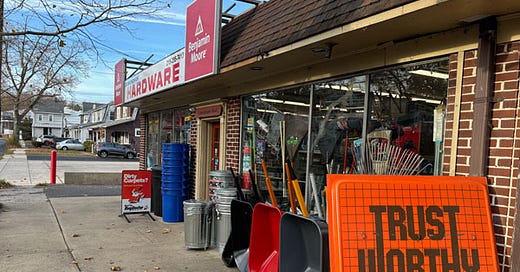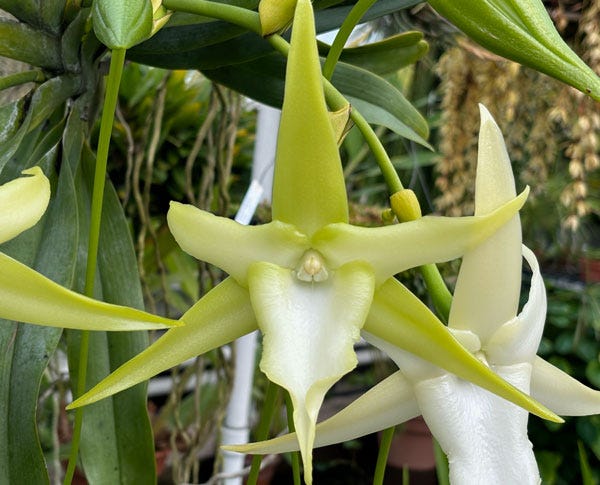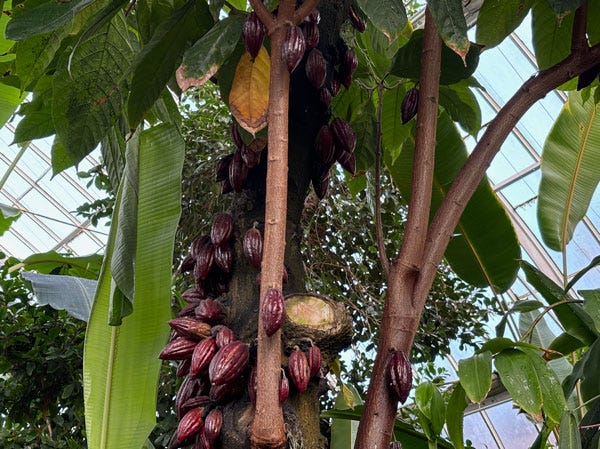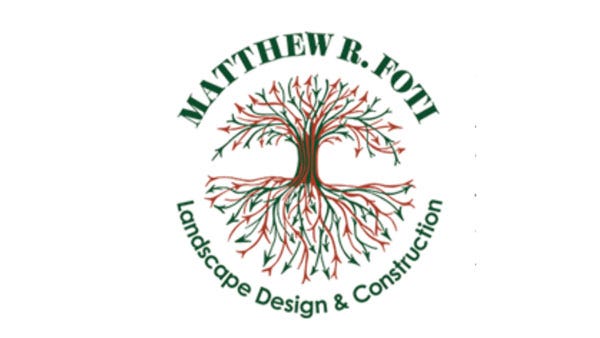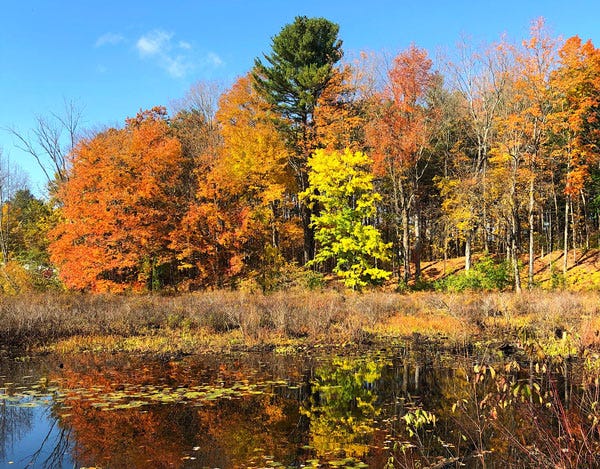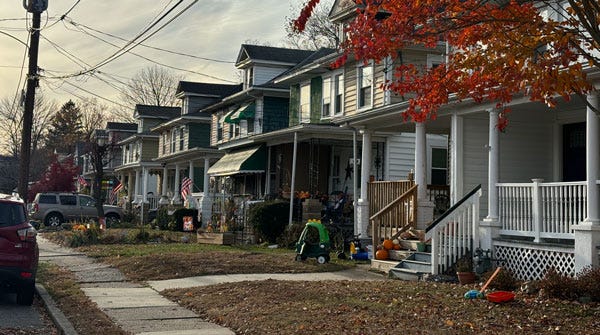Wednesday Walk: Trees, Roots, and Roads
Seeing a cocoa tree up close, looking beneath the surface, and comparing road designs
Welcome to Willoughby Hills!
Every Wednesday, I offer a few short ideas that I hope will inspire you to do some more reading, thinking, and exploring. Let’s take a little walk together and see where the path leads…
Up Close with Cocoa
My parents visited us over the weekend and we did some touristy things with them. My mom has always liked visiting botanic gardens, but being new to Western Massachusetts, I wasn’t too familiar with what was around here.
A quick Google search turned us on to the Botanic Garden of Smith College in Northampton. During the growing season, they have an outdoor six acre outdoor garden and 127 acre arboretum that look stunning (both of these are technically open year-round, although there’s much less to see in the winter). We stopped by to visit the 12,000 square foot conservatory.
It’s been a long time since I wandered through an indoor botanic garden and I was charmed. There were several greenhouse rooms depicting different climates- some hot and humid, others hot and dry, and others more temperate.
I loved seeing beautiful flowers like orchids of all shape and color on display.
I also really liked seeing the edible trees growing. The collection includes citrus, olives, figs, coffee plants, and a cocoa tree. I had never seen a cocoa tree before, not even in a picture, so it was fascinating to observe.
Unlike most trees that have fruit growing at the end of long branches, the cocoa seeds (which we usually call beans) grow in pods that hang off the main trunk of the tree. They were brownish in color and almost resembled a pepper or eggplant. The seeds/beans are harvested, roasted, and ground to make chocolate.
I love learning and observing the world around me, and I especially appreciate places like museums and botanic gardens that can make learning accessible and pique my curiosity.
Our Hidden Roots
The botanic garden also featured an incredible art installation by Moroccan artist Younes Rahmoun called “Habba,” which means seed.
It was an unexpected surprise to find this show after wandering through greenhouses and observing plants.
Without giving too much away, the show takes place in a darkened room and involves projected drawings shown in sequence along with aural effects. It starts out very abstract, but then becomes slightly more figurative, while still retaining some mystery and beauty.
One piece of the show that really affected me was an animation that shows a seed beginning to grow. Our experience of watching a seed first sprout usually happens entirely above the soil: we see that first green stem and those two cotyledons, or first leaves, appear.
But what Rahmoun’s show reminded me is that there is an equally beautiful and almost symmetrical process happening below the soil at the same time, as roots reach out into the soil, seeking water and nutrients.
As somebody who enjoys gardening, I was of course aware that plants have roots. I even had a visual in my mind of the symmetry of the branches and roots of trees.
One of the tree experts that I used to work with at This Old House, Matt Foti, used an image of that as the logo for his company. It was printed on his T-shirts and adorns his website.
But there was something about the way that Rahmoun chose to show that symmetry as a process rather than a static image (again, trying not to give too much away) was really affecting to me.
As we left the garden and began to walk around the Smith College campus, I marveled at the tall trees around me that were likely close to 100 years old, if not older. But for the first time, instead of just seeing the trunk, bark, and branches, I also thought about the roots.
I imagined the complex network underground and it got me thinking about other humans.
We all have an elaborate root system. In a very literal sense, it’s the veins and arteries that course through our bodies.
But in a more metaphorical sense, our roots are hidden beneath what everybody sees. Our roots are our belief systems, our trauma, our ways of seeing and relating to the world learned and refined through our entire life.
Just as we usually only perceive of the above-ground portion of a tree, we often focus only on what we can see in others. We don’t think about what is happening “underground” in all of us.
When we consider those roots, that past, those habits and distractions, it allows us to give others a bit more grace. To allow others some slack. And to get back to The Four Agreements (which I’ve written about before), to “not take things personally."
I encourage you to visit Smith College in Northampton, MA if you can and check out Rahmoun’s work, which is being exhibited across the campus through the summer. If you’re not able to make it and are curious, Rahmoun does have a video of “Habba” on his website, although watching it on a computer or phone is nothing like watching the film in a dark room.
Against Biomimicry
The roots and branches of a tree are a pattern that are replicated a lot in nature: the flow of our blood from main arteries to veins to capillaries and the progression of water from tiny tributaries to a raging river.
This pattern gets repeated in our built environment as well. As Philip Langdon points out in A Better Place to Live (which I mentioned in Sunday’s newsletter), most modern suburban roads follow a hierarchy: limited-access highway (think highways and interstates), arterial roads (where the big box stores and fast food restaurants are), collector roads (the access to suburban neighborhoods), and finally minor streets (where suburban houses are located).
When I first read Langdon describe this, I immediately thought of the natural patterns I described above: tree roots and branches, river tributaries, our circulatory system. Langdon compares this road hierarchy to another part of our built environment: utility delivery systems for electricity, drinking water, and waste water.
This ordering system makes sense in many cases, in my mind because it is ultimately rooted in nature, but Langdon believes that road and neighborhood design are where this idea reaches its limits.
This layout style can be erratic and unpredictable, making walking (and sometimes driving) confusing and disorienting. Because of how traffic flows from small roads with homes to busier roads with businesses, there is almost never walking access to anything but other homes. And since traffic of all kinds (both foot and vehicular) must flow towards busier roads with limited access, walking can often become longer and more roundabout than necessary.
Langdon insists that the best neighborhood design is the simple grid, which is how cities have been traditionally laid out for hundreds of years. Grids present multiple choices as each intersection is a new possibility for exploring in a different direction. But because the grid is consistent, navigation becomes easier.
We spent Thanksgiving renting an AirBnB in a walkable neighborhood in Morrisville, PA. The houses were all close to the street and everything was laid out in a grid. When I took our dog for walks, it was fun to explore in new directions but still feel like I had my bearings.
At one point, I stumbled upon a hardware store nestled amongst the houses about two blocks from where we stayed. I was envious of the folks that lived in this neighborhood who could walk to a store like this to pick up nails or wire nuts in the middle of a project. For me in a more suburban area, that same errand requires a 15 minute drive to Home Depot.
At the edge of the houses, still within walking distance of our rental, was a small shopping center with a grocery store, a number of restaurants, and that bizarre return liquidation store I wrote about last week.
It’s interesting to me that most of the time, mimicking nature is the best path forward, but I agree with Langdon that in the case of neighborhoods, the grid beats the hierarchy.
If you’re interested in looking into the walkability of your own neighborhood, check out this article full of great visuals and maps from Harry Stevens for the Washington Post (and hat tip to Jesse Hisrch for sharing this with me!)
I publish new issues every Wednesday and Sunday. Sign up to always receive the latest issue and support my work:
Other Wednesday Walks
If you’ve missed past issues of this newsletter, they are available to read here.


